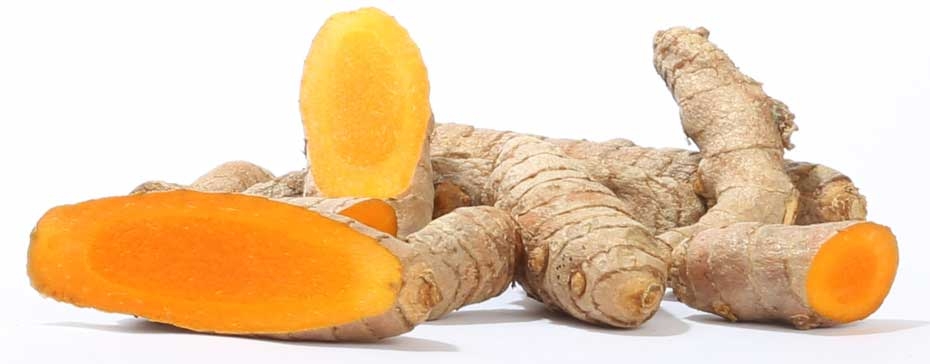Turmeric is one of the most popular supplements in the UK thanks to its anti-inflammatory effects. In this article, we look at the history of the remarkable plant and how you can achieve the best results from taking a turmeric extract.
- What is turmeric?
- Where does turmeric come from?
- What is curcumin?
- What are the health benefits of turmeric?
- How to take turmeric
- Foods rich in turmeric
- Does turmeric interact with medications?
- How much turmeric should I take?
- The best turmeric supplements
- Summary
- References
What is turmeric?
The turmeric plant (curcuma longa) is a herbaceous plant of the ginger family. The original home of the plant is unknown but it is thought to be native to tropical areas of either the Indian Subcontinent or Southeast Asia.
The plant requires warm temperatures and plenty of rainfall to grow. It grows to a height of more than three feet, has large green leaves and is notable for its thick tuberous roots and rhizomes which are harvested to produce the popular spice.
The root is what we all recognise as turmeric and this is used to create the distinctive yellow powder.
Where does turmeric come from
Fresh turmeric root has been used in India for centuries in cooking, traditional medicine, religious practices and even as a cosmetic. It was also used in ancient Chinese medicine and as a pigment to dye the robes of Buddhist monks.
The roots are harvested every year, then boiled and ground to produce the familiar yellow turmeric powder that is used as a natural flavouring and colouring agent in food.

Best known for the warm, earthy flavour and the golden tint it lends to curries and other South Asian dishes, turmeric has also been used medicinally for thousands of years.
The root was known to westerners as early as Marco Polo’s 13th-century journey to Asia, but the potential for health was not recognised until the 20th century. These days you can buy turmeric lattes, teas, and of course many different types of turmeric supplements.
What is curcumin?
Around 3-5% of the raw turmeric root is made up of curcuminoids. These bioactive compounds are a type of polyphenol, and are responsible for the golden colouring of the root. The three major curcuminoids are curcumin (over 70% of curcuminoids), demethoxycurcumin (DMC) (15-18%), and bisdemethoxycurcumin (3-6%).
Curcumin is the best-researched active ingredient, despite it forms only 3% of turmeric1.
Curcumin benefits are often limited by its low bioavailability. This is due to multiple factors such as poor water solubility and rapid elimination from the body.
So you can see that, unless you include turmeric powder in most of your foods (as they do in Indian cuisine), you’re probably getting very little curcumin into your body. A bioavailable curcumin supplement is far more effective than eating turmeric powder.
What are the health benefits of turmeric?
Turmeric supplements are becoming a popular choice for people with joint conditions, and research has shown it is a powerful anti-inflammatory.2. Many chronic conditions are caused or exacerbated by inflammation, including arthritis and heart disease.
Given these findings, scientists have prioritised research into the effects of curcumin, with over 40 published human studies focused on FutureYou’s patented formulation alone.
What is turmeric good for?
Various studies have found that curcumin:
- can play a role in supporting and maintaining healthy and flexible joints.3
- may help with normal muscle recovery after high-intensity exercise4,as well as helping to reduce delayed onset muscle soreness (DOMS)5. Studies conducted with elite athletes have shown that curcumin aids muscle recovery after high-intensity exercise5 which allows for better training and improved performance over time.
- is a powerful antioxidant2. Antioxidants help to protect cells from oxidative damage caused by the environment or as a by-product of normal metabolism.
- can help to improve memory and mood in people with mild, age-related memory loss6.
How to take turmeric
There are two main ways you can take turmeric - in supplement form or by adding it to food and beverages. Each method will result in different levels of curcumin (the active ingredient) being absorbed in the body, and getting to where it is needed the most.
Here we take a look at the advantages and disadvantages of each method.
Foods rich in turmeric
In Indian food, turmeric is cooked with animal or plant fats such as butter or coconut oil. In traditional Indian medical use, turmeric is often diluted in warm milk. Putting turmeric into a lipolytic – or fatty – matrix like this provides the means for the active ingredient curcumin to be absorbed by the body.

Indian and South-East Asian cuisines commonly include turmeric. The root is used to lend its golden colour and warming flavour to curries, dhals, soups, rice dishes and more. Today, it has even become popular to include it in smoothies or to eat it with scrambled eggs.
Turmeric supplements?
Curcumin forms only 3% of turmeric1, meaning that supplements are probably more effective than eating turmeric powder.
You should choose a turmeric supplement that is bioavailable so that your body can absorb more of the beneficial curcumin – typically curcumin is difficult to absorb, and you can only obtain benefits if it reaches your bloodstream7.
A more bioavailable supplement also means that you can achieve positive effects with less turmeric while reducing the chances of experiencing side effects.
There is clear evidence for the effectiveness of curcumin (the major active ingredient naturally present in turmeric) in a wide range of clinical applications 11,2.
However, curcuminoids are not easily absorbed by the body in their raw state – they are not ‘bioavailable’.
Does turmeric interact with medications?
Many people wonder about the compatibility of turmeric/curcumin supplements with medications such as anticoagulants and antiplatelet agents.
Anticoagulants and antiplatelet agents are frequently used for the prevention and treatment of a wide range of cardiovascular and cerebrovascular diseases. Warfarin (commercialised as Coumarin®) is the most widely prescribed anticoagulant in the UK8. These medications are more likely than any other to interact with herbal supplements and medicines9.
Theoretically, curcumin may increase the effects of anticoagulants and antiplatelet agents – possibly increasing the risk of bleeding – because in vitro and animal studies have shown that curcumin can have an anticoagulant effect10.
If you are taking any medication or preparing for a medical procedure, you should consult your doctor or pharmacist before taking any food supplement. Every person is different and will respond in their own way to a food supplement. If you begin feeling unwell, stop taking the food supplement and continue with the medication.
Nevertheless, you can be confident that there is data from patients that supports the conclusion that curcumin and warfarin can be taken together11. You can read about some of the studies on our dedicated Knowledge Centre page.
How much turmeric should I take?
Every person is different. Your body will metabolise some compounds very well and may struggle with others. For this reason, finding the right dose of a supplement is not an exact science.
You should begin by taking the recommended dose of your chosen turmeric supplement. If you would like to take it easy on your stomach you could try starting with a smaller dose and building up to the recommended amount over time.
Ideally, you only want to absorb enough curcumin to have the effect you are expecting, and no more. If you experience unwanted side effects when taking turmeric, you should stop immediately and talk to your doctor or pharmacist before resuming.
The best turmeric supplements
As Curcumin forms only 3% of the turmeric root1, many supplements contain enriched turmeric extracts that provide up to 95% curcuminoids.
However, it is not the amount of the active ingredient that is the most important factor. If you’re looking for the best turmeric supplement on the market, you need to find out whether your chosen product is easy to absorb (bioavailable).
Curcumin is difficult for the body to absorb in its raw state, primarily because it is not soluble in water. It is also poorly soluble in lipophilic – fatty – solvents7. Many supplements on the market have not addressed the issue of bioavailability and are therefore less effective since if the curcumin isn’t absorbed it won’t do any good.
Black pepper
To address the issue of bioavailability, many supplements do now contain black pepper. It is thought that black pepper improves absorption by inhibiting the natural processes that prevent pharmacological compounds from accumulating in the body, by possibly:
Read more on black pepper and turmeric
- Increasing the absorptive surface on the small intestine and/or permeabilising the epithelial barrier (making it easier for the curcumin to get into the gut cell)17
- Inhibiting cellular efflux mechanisms such as P-glycoprotein (P-gp). This is a membrane transporter used by cells to secrete compounds such as chemotherapeutic agents and other drugs. In this case, decreases the secretion of curcumin absorbed in the intestine12.
- Inhibiting glucuronidation, a process that makes substances/drugs more water soluble so they can be easily eliminated from the body13.
Although piperine has been shown to increase curcumin absorption in the body, because it does it through a non-selective method (by inhibiting the secretion or increasing cell permeability), it is not clear what the effect of long-term use of piperine might be.
Liposome
You can also find supplements thatcontain curcumin in a liposome/micelle form where the active ingredient is encased inside a lipid cavity(basically, the curcumin is in the centre of a drop of fat). Curcumin liposomes have been used in some early studies for cancer treatment, where the liposome is given intravenously (injected directly in the blood).
Liposomal curcumin oral supplementation has been shown to increase curcumin levels in blood 14 but there isn’t much research data linking this increase to beneficial effects.
One particular liposomal formulation was used in one human study in moderately hyperlipidemic individuals15, but it didn't show any effect at all, in comparison to other curcumin formulations.
Phytosome
A phytosome is a lipolytic complex of a natural active ingredient (such as curcumin) and lecithin, a natural fat16. It looks similar to a liposome, but in this case, the active molecule is attached to the fat, so it can be found all over the drop, instead of just being concentrated in the centre.
Due to this difference in structure, phytosomes are more stable and are able to deliver more active ingredient than liposomes 17
Turmeric (and curcumin) are traditionally mixed with fats (ghee, coconut milk, oil) in Indian cuisine. Similarly, a formula that incorporates phytosome technology is able to boost absorption in a natural way by mimicking the intake of turmeric with food.
A specific curcumin phytosome has been the subject of numerous studies covering 10 different areas including eye health, joint health, rheumatoid arthritis and pain relief, conducted in healthy volunteers and patients, have validated the effectiveness of this formulation.
What does this mean?
The effectiveness of a curcumin supplement depends on achieving greater absorption using the right methods. Finding a ‘natural’ way to improve bioavailability (such as phytosome technology) is important as it is less likely to cause tolerability issues or unknown side effects with long-term use.
However, improved absorption is just a part of it. An effective curcumin supplement should be backed by human studies to prove that it is able to get where it is needed in the body.
Summary
For centuries, people in Asia have used the root of the turmeric plant in cuisine, religious practices and as a dye thanks to its golden colour. It has also been a mainstay of traditional medicine.
Today, with the help from science and technology, turmeric has become a popular supplement worldwide. Many studies have revealed the antioxidant and anti-inflammatory properties of one of its active ingredients, curcumin.
It is now used by many people as curcumin can help with a great variety of health areas, from muscle recovery after intense exercise to skin health.
Unfortunately, curcumin is difficult for the body to absorb, so it is important to find a way of consuming turmeric that improves its bioavailability.
References
1. Nagpal M & Shaveta S. Role of curcumin in systemic and oral health: an overview. J Nat Sci Biol Med. 2013; 4(1):3-7.
2. Hewlings SJ & Kalman DS. Curcumin: a review of its’ effects on human health. Foods. 2017; 6(10) pii: E92
3. Yang M, Akbar U, MOhan C. Curcumin in autoimmune and rheumatic diseases. Nutrients. 2019; 11(5) pii: E1004
4. Heaton LE, Davis JK, Rawson ES, Nuccio RP, Witard OC, Stein KW, Baar K, Carter JM, Baker LB. Selected in-season nutritional strategies to enhance recovery for team sport athletes: a practical overview. Sports Med. 2017; 47(11): 2201-2218
5. Drobnic F, Riera J, Appendino G, Togni S, Franceschi F, Valle X, Pons A, Tur J. Reduction of delayed onset muscle soreness by a novel curcumin delivery system (Meriva®): a randomised, placebo-controlled trial. J Int Soc Sports Nutr. 2014; 11:31.
6. Sarker MR, Franks SF. Efficacy of curcumin for age-associated cognitive decline: a narrative review of preclinical and clinical studies. Geroscience. 2018; 40(2):73-95
7. Anand P, Kunnumakkara AB, Newman RA, Aggarwal BB. Bioavailability of curcumin: problems and promises. Mol Pharmaceutics. 2007; 4(6): 807-818
8. NHS conditions, Anticoagulant medicines, Overview.
9. Posadzki P, Watson L, Ernst E. Herb-drug interactions: an overview of systematic reviews. Br J Clin Pharmacol. 2013; 75(3):603-618
10. Ulbricht C, BaschE, Barrete E, Boon H, Chao W, Costa D, Higdon ER, Isaac R, Lynch M, Papaliodis G, Serrano J, Varghese A, Vora M, Windsor R, Woods J. Turmeric (Curcuma longa): an evidence-based systematic review by the natural standard research collaboration. Altern Complement Ther. 2011; 17: 225-236
11. Hu S, Belcaro G, Dugall M, Peterzan P, Hosoi M, Ledda A, Riva A, Giacomelli L, Togni S, Eggenhoffner R, Cotellese R. Interaction study between antiplatelet agents, anticoagulants, thyroid replacement therapy and a bioavailable formulation of curcumin (Meriva®). Eur Rev Pharmacol Sci. 2018; 22(15): 5042-5046
12. Najar IA, Sachin BS, Sharma SC, Satti NK, Suri KA, Johri RK. Modulation of P-glycoprotein ATPase activity by some phytoconstituents. Phytother Res. 2010; 24(3):454-458.
13. Wang R, Han J, Jiang A, Huang R, Fu T, Wang L, Zheng Q, Li W, Li J. Involvement of metabolism-permeability in enhancing the oral bioavailability of curcumin in excipient-free solid dispersions co-formed with piperine. Int J Pharm. 2019; 561:9-18
14. Schiborr C, Kocher A, Behnam D, Jandasek J, Toelstede S, Frank J. The oral bioavailability of curcumin from micronized powder and liquid micelles is significantly increased in healthy humans and differs between sexes. Mol Nutr Food Res. 2014; 58(3): 516-527
15. Kocher A, Bohnert L, Schiborr C, Frank J. Highly bioavailable micellar curcuminoids accumulate in blood, are safe and do not reduce blood lipids and inflammation markers in moderately hyperlipidemic individuals. Mol Nutr Food Res 2016; 60(7): 1555-63.
16. Nanavati B. Phytosome: a novel approach to enhance the bioavailability of phytoconstituent. Asian J Pharm. 2017; 11(3)
17. Smilkov K, Ackova DG, Cvetkovski A, Ruskovska T, Vidovic B, Atalay M. Piperine: Old Spice and New Nutraceutical? Curr Pharm Des. 2019;25(15):1729-1739
18. Kady S, Apte M, Phytosome: A Novel Approach to Enhance the Bioavailability of Phytoconstituent Anila2017

